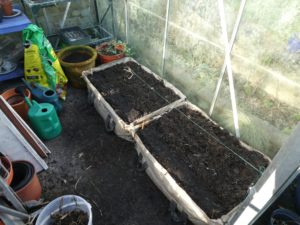Well, I am still on strike. At least it means I can take advantage of any non-horrid weather to get some garden jobs done. This time of year is when I do one of the most physically demanding tasks: removing last year’s compost from the greenhouse and putting some fresh compost in, so that it is ready for the tomatoes.

The greenhouse has a hard concrete floor, so the only way to grow stuff in it is to have compost in gro-bags or containers. These big cloth containers do a good job: holding enough compost for the tomato plants and maybe a cucumber and a winter squash. They are filled with my own compost. You know for sure you are middle-aged when you develop any opinion on compost, but the cliche that a compost heap is the engine room of a garden has become a cliche because it is so true. In go weeds, grass clippings, dead plants, vegetable kitchen waste etc. etc., and out comes rich, crumbly non-smelly growing medium. It is a cross between biochemical engineering and magic. As any good chemical engineer knows, you would never choose a batch process over a continuous-flow process. So, my compost heap is one where I put the source material in at the top and shovel the compost out at the bottom.

This has the obvious advantage of taking up less space in the garden than having one heap that you are building up, one that is sitting there rotting to itself and a third that you are digging usable compost out of. At 320 m2 (0.032 hectares or 0.08 acres in old money) mine is not the smallest garden around and is quite a lot larger than many town gardens. But it is certainly not Chatsworth, and the compost bin does not need to be taking up more space than necessary. It helps to have the bin in an angle of two walls, in the darkest corner of the garden, although this does mean that there is a corner of the bin right at the back that I struggle to access when digging compost out: there is probably a small wedge of material back there which is very well-rotted indeed. You can see from the picture that the sides of the bin slope inwards. I have found by experiment that this is absolutely necessary: if the sides are all vertical, the compost tends to stay stuck at the top of the bin and refuses to drop down to the bottom.
I hypothesise that another advantage of a continuous-flow compost bin is that the complex community of bacteria, fungi, worms, slugs, woodlice and so forth is not lost as it would be when you empty a batch compost heap and start a brand new one from scratch. I have no data to quantify this, but my impression is that the longer I have kept the bin going, the better it works.
The old compost which I have removed from the greenhouse may have been denuded of nutrients by the tomatoes, but it still has beautiful texture; I have spread it onto the vegetable beds to improve the soil quality. It is not at all difficult to improve on the stuff you find in my garden if you remove some turf and dig a new bed: that seems to be composed mostly of sand and gravel.

